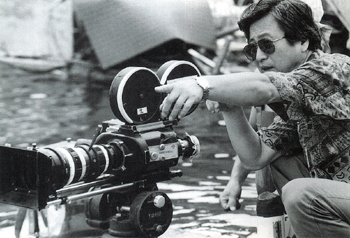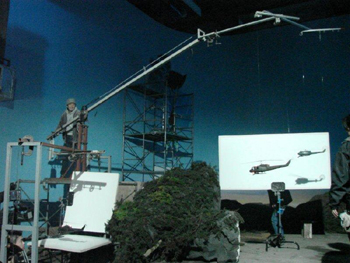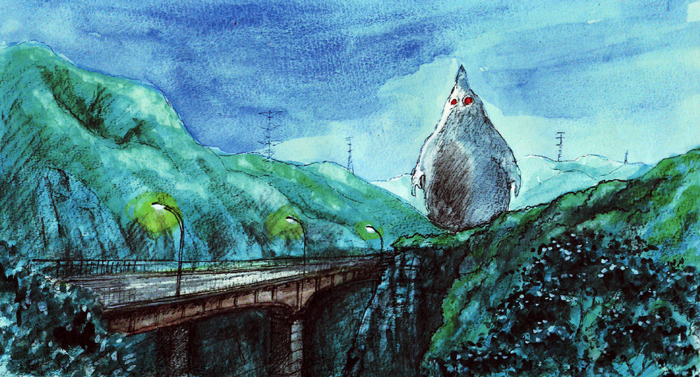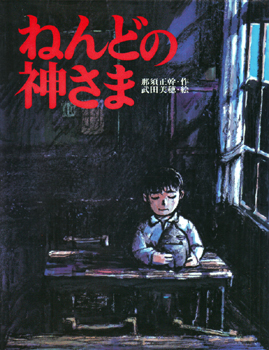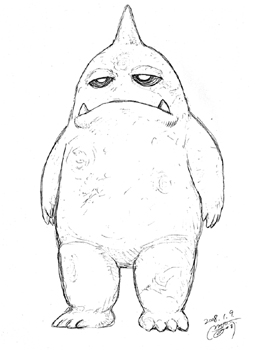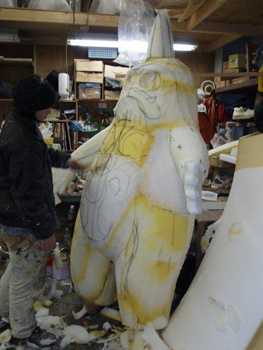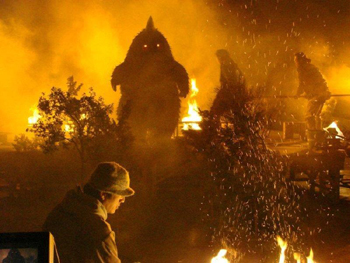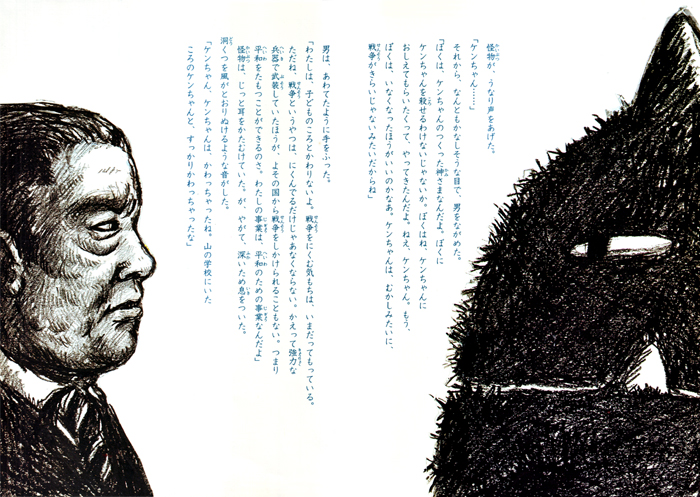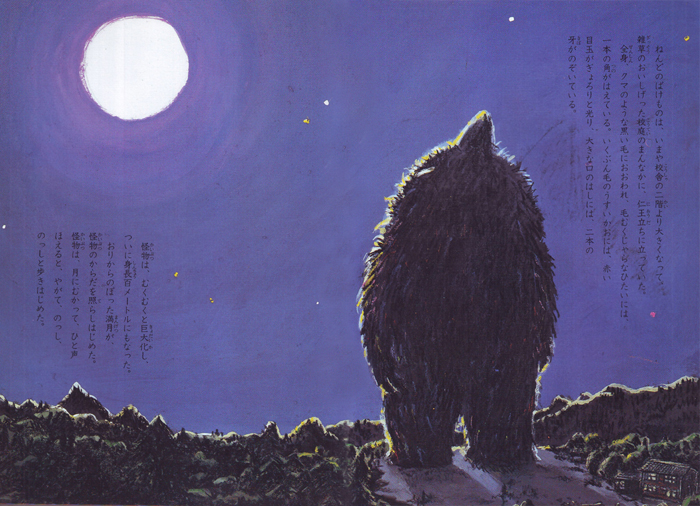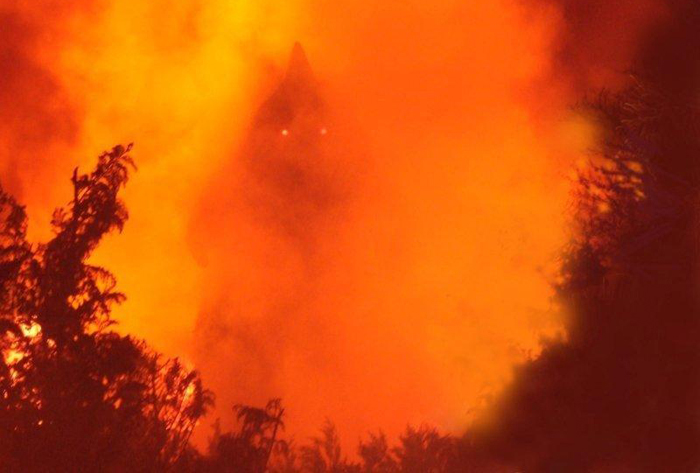
A SciFi JAPAN EXCLUSIVE
It’s no exaggeration to say that Koichi Kawakita brought Godzilla back to life. When he took over as special effects director of the long-running film series with GODZILLA VS. BIOLLANTE (??? VS ?????, Gojira tai Biorante, 1989), Kawakita rejuvenated a franchise that was creatively and technically moribund and introduced a new-look Godzilla that redefined the monster for a whole new generation of fans worldwide. Kawakita went on to work on a total of six Godzilla movies, the last being GODZILLA VS. DESTOROYAH (??? VS ??????, Gojira tai Desutoroia, 1995). More recently, Kawakita was a creative force behind a project that is decidedly smaller in scale yet has much in common with the Godzilla franchise, from the antiwar theme that propelled the original GODZILLA (???, Gojira, 1954) to the traditional Japanese analog special-effects techniques that define the entire genre it begat. THE GOD OF CLAY (???????, 2009/2011) is a 13-minute short film that pays homage to the classic tokusatsu films and television shows of the 1950s and 60s. The film, on which Kawakita shares co-director credit with Nobuaki Sugimoto, has never been shown publicly, not even in Japan. Its world debut will be held at 9:30 p.m. on Thursday, June 23 at the Bigfoot Crest Theater in Westwood, CA.
THE GOD OF CLAY is the story of Ken-chan, a boy whose parents are killed in World War II. As a child, Ken creates a tiny clay god to symbolically punish warmongers for the destruction they`ve wrought, but then the film flashes forward 50 years and Ken has grown up to become president of a Japanese defense contractor— the very type of war profiteer he`d once blamed for his parents` death. Ken`s long-forgotten God Of Clay grows to enormous size, wreaking havoc and destruction as it treks across the countryside toward Tokyo (including the requisite battles with the military) until it confronts its maker. Kawakita took over the reins of the production from Sugimoto, a documentary filmmaker, who helmed the initial footage. The film was produced by Marbling Fine Arts, a miniature effects production house that has worked on numerous high-profile Japanese special-effects productions over the past two decades including the Heisei Godzilla series, Ultraman television series and the Heisei Gamera series. A crew of roughly 30 special effects artists and craftsmen gave their talents to the film: the monster suit was created by Eizo Kaimai’s company (Kaimai helped create the original Godzilla suit in 1954); the directors of photography were Takehiro Kuramochi (ULTRAMAN TIGA, ULTRAMAN MEBIUS) and Keiichi Sakurai (REBIRTH OF MOTHRA III); the late Tetsuzo Osawa (Heisei Godzilla series, ULTRAMAN MEBIUS & ULTRAMAN BROTHERS) was the SFX production designer; legendary background painter Fuchimu Shimakura (MADADAYO, DESTROY ALL MONSTERS, GODZILLA: FINAL WARS) created the beautiful background artwork; and Shinji Nishikawa (designer of Heisei Godzilla monsters such as Biollante, King Ghidorah, Baby Godzilla and Little Godzilla) created storyboards and designed the creature.
Kawakita granted Sci Fi Japan this exclusive interview, which was conducted by correspondence with an assist from THE GOD OF CLAY producer Norihiko Iwasaki... Steve Ryfle: How did you become involved in the making of THE GOD OF CLAY?
Koichi Kawakita: I thought the theme of the movie, “peace and love,” was beautiful. I wanted to come in as a sort of film doctor, and express that theme onscreen in a better way. Steve Ryfle: Would you describe your role in co-directing the film? Koichi Kawakita: There were some fundamental problems in the original scenario, so I went back to it with a sci-fi perspective and reconstructed the film. I supervised the editing for the entire film, both live-action and SFX scenes. I added new shots and re-edited the entire film. Steve Ryfle: We understand that the film was made at a time when many SFX artists were lacking work. How were so many talented people recruited? Koichi Kawakita: After we heard that the legendary studio Toho Built was being closed down, many of us who had a strong desire to see Japanese special effects work make a comeback had a passionate discussion about it. At the time, we all felt the same way about it and it just so happened that none of us were all that busy. Steve Ryfle: We also understand that the crew members donated their time and work. Can you describe their enthusiasm for the project? Koichi Kawakita: Everyone was happy to work on this project since it was our project. We, the members of the effects crew, are not like directors or writers; usually it’s not us who drive the project. But this time, we were the leaders of the project. We felt we were working to save our community and spirit.
Steve Ryfle: What can you tell us about the design of the God of Clay? Koichi Kawakita: We had our storyboard illustrator, Shinji Nishikawa, handle the monster design. The design is based on the illustrations in the original book, so our goal was to not change that style too much. Shinji added fingerprints on the belly. Steve Ryfle: Were any of the materials (miniatures, props, etc.) left over from other film or TV productions? If so, which productions? Koichi Kawakita: We recycled miniatures made for the Heisei Godzilla series and Ultraman television shows. All those miniatures owned by Marbling Fine Arts. Steve Ryfle: The crew was a mix of the Tsuburaya generation (such as yourself and Mr. Shimakura) and younger talent. What was the working atmosphere like? Koichi Kawakita: Our teamwork was excellent because the staff felt that they themselves had become the main characters, so we were able to come together. Steve Ryfle: Do you believe the craft and culture of traditional, analog Japanese special effects is being adequately handed down to future generations?
Koichi Kawakita: I believe so. It is a form of traditional art, a sort of established tradition. Like other forms of traditional Japanese art, such as Noh or Kabuki, tokusatsu should be passed down from generation to generation. If anything, what is most important is to continue making films so that our successors will always have a place to go. Steve Ryfle: In recent years, Japanese SFX productions have introduced more and more digital effects. Do you think analog effects will survive? Koichi Kawakita: At least in some form, I think it will survive. It depends on what the audience wants. No matter how many films you make, if there`s no audience to watch them, then there`s no point. We should think about how to create demand for tokusatsu products. We need to find ways to expand the market. Steve Ryfle: What will Japanese SFX look like in 10 or 20 years from now? Koichi Kawakita: Our generation should lead younger people and preserve our tradition for the coming years. As long as we respect the traditional techniques, I think we`ll be able to build on everything from here on out. In order for special effects films to continue into the next 10-20 years, we need to be able to build on our skills. In that way, I hope to create a new film project and present it to audiences. Steve Ryfle: We understand that THE GOD OF CLAY has never been publicly screened before, not even in Japan. Why not?
Koichi Kawakita: In Japan, there are not many opportunities to show a short film like this. In addition, rather than screening the film for its own promotion, we used it as a kind of demo reel to demonstrate our skills. Also, because it`s based on a book, there were rights issues and we couldn`t give it a wide release. This [June 23] screening is by courtesy of the publisher. Steve Ryfle: What are your feelings about the film making its American premiere? Koichi Kawakita: It’s wonderful to see Japanese tokusatsu movies are being accepted overseas like this. Knowing that we have such amazing fans overseas is truly a great thing, Steve Ryfle: Any parting thoughts? Koichi Kawakita: This movie expresses our anger and sadness created by “the war.” In Japan, “the war” usually means WWII. Its message is, "how foolish we would be to go down that path again, even risking destroying ourselves." This movie is telling us, “Don’t make the same mistake again. Remember the sadness and anger caused by the war 60 years ago.”
THE GOD OF CLAY and GODZILLA VS THE SEA MONSTER June 23rd, 9:30 PM The Bigfoot Crest Theater 1262 Westwood Boulevard (just south of Wilshire Blvd. in Westwood) Los Angeles, CA 90024-4801 Box Office Phone: (310) 474-7824 Recorded Program Info: (310) 474-7866 Ticket Prices: $11 General Admission $8 Seniors & Students with valid student I.D. Advance tickets are generally available several weeks before the date of the program. Advance sales available through Fandango, or at the Bigfoot Crest box office, which opens 30 min. prior to the first show of the day. Parking: Parking meters on Westwood Blvd. are free after 7:00 PM with a 2 hour limit before that. There is a lot directly behind the theater run by Standard Parking which charges a $4 flat fee after 4:00 PM.
For more information on THE GOD OF CLAY world premiere, please see the earlier coverage here on SciFi Japan:
Veteran Toho SFX Director Helmed New Indie Giant Monster Short, Making Its U.S. Debut This Week Author: Steve Ryfle Translation: Oki Miyano Special thanks to Toshiko Iwasaki, Norihiko Iwasaki, Dennis Bartok, and Elliot Gay


